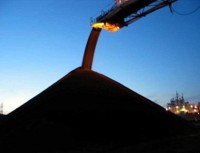Clean Coal Technologies Markets and Trends Worldwide
 Coal is expected to continue to be a dominant fuel in power generation due to its low cost and abundance.
Coal is expected to continue to be a dominant fuel in power generation due to its low cost and abundance.Nearly 7 billion tonnes of coal were produced globally in 2010, and over 40% of global electricity was coal powered. On a levelized cost of production basis, the global market value of coal-fired electricity exceeded $400 billion.
Nonetheless, conventional coal power generation is a leading contributor to global greenhouse gas emissions and is increasingly being regulated and disincentivized. Further, clean andrenewable energy sources are beginning to challenge conventional fossil fuels.
Several clean coal technologies that increase efficiency of coal power plants and reduce emissions are actively being developed and deployed to meet these challenges.
As development and adoption of these technologies has increased, the global value of electricity generation using clean coal technologies has concurrently grown to $63 billion in 2010 and is further expected to grow to $85 billion by 2020.
While coal washing, particulate, and emissions treatments have been in use for several decades, recent advances in these technologies have substantially improved the effectiveness and reduced the cost of these solutions.
As a result of these advances and increasing emissions regulation around the world, the adoption of technologies that reduce SO2, NOx and particulate emissions has accelerated over the past decade.
Concurrently,combustion technologies including super critical (SC), ultra-super critical (UC) pulverized coal combustion (PCC), and circulating and pressurized fluidized bed combustion (FBC) technologies are increasing the power conversion efficiencies of coal power plants.
These advanced technologies have enabled simultaneous improvements in emissions and economics of coal-fired generation.
Advanced power plant designs incorporating gasification and combined cycle power generation (IGCC) have also been recently commercialized and have demonstrated significantly higher efficiencies of up to 45 percent.
Such high efficiency coal power technologies reduce the production of carbon dioxide as they combust less coal per unit of power generated and have demonstrated emissions reductions of up to 33 percent over conventional pulverized coal technologies.
However, the greatest opportunity for the coal industry to reinvent itself as a clean powersource lies in the maturation and deployment of carbon capture and sequestration technologies (CCS).
CCS technologies enable the capture of carbon dioxide from coal power conversion processes and sequester it in underground and offshore geological formations; virtually eliminating greenhouse gas emissions from coal combustion.
While CCS technologies and processes have been leveraged in industrial and oil and gas applications for decades, it is only in recent years that the technologies have been adapted and demonstrated on large-scale coal power plants. The success of these early projects could pave the road for truly clean coal power.
Global Clean Coal Technologies and Markets provides a detailed discussion of the key technologies, deployed or in development, to address the environmental impact of coal.For more information and to request sample contents, click here.
You can return to the main Market News page, or press the Back button on your browser.

